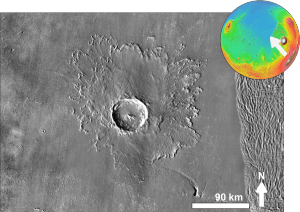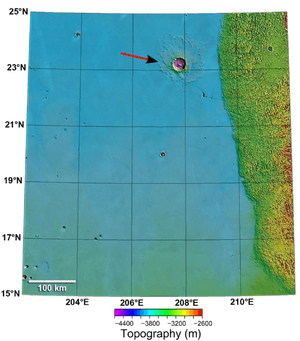Tooting (crater)
 | |
| Planet | Mars |
|---|---|
| Coordinates | 23°06′N 207°06′E / 23.1°N 207.1°ECoordinates: 23°06′N 207°06′E / 23.1°N 207.1°E |
| Diameter | 28 km |
| Depth | 1200 metres |
| Discoverer | Pete Mouginis-Mark |
| Eponym | London suburb |
Tooting is a multi-layered fluidized ejecta crater (a type of rampart crater) at 23.1°N, 207.1°E, in Amazonis Planitia (Amazonis quadrangle), due west of the volcano Olympus Mons, on Mars. .[1] It was identified by planetary geologist Peter Mouginis-Mark in September 2004. Scientists estimate that its age is on the order of hundreds of thousands of years, which is relatively young for a Martian crater.[2] A later study confirms this order of magnitude estimate.[3] A preliminary paper describing the geology and geometry of Tooting was published in 2007 by the journal "Meteoritics and Planetary Science", vol. 42, pages 1615 - 1625. Further papers have more recently been published, including a 2010 analysis of flows on the walls of Tooting crater by A.R. Morris et al. ("Icarus vol. 209, p. 369 - 389), and a 2012 review paper by P.J. Mouginis-Mark and J.M. Boyce in "Chemie der Erde Geochemistry", vol. 72, p. 1 - 23. A geologic map has also been submitted in 2012 to the U.S. Geological Survey for consideration and future publication.

Naming
Tooting is named after the London suburb of the same name. This is in accordance with the International Astronomical Union's rules for planetary nomenclature, which specify that craters on Mars less than 60 km in diameter should be named after "villages of the world with a population of less than 100,000".[4] The discoverer named it after his home town because he "thought [his] mum and brother would get a kick out of having their home town paired with a land form on Mars".[5] This caused a stir in the British press, with many well-known media outlets reporting on the issue.[6][7][8]
Geology
The crater's youth was inferred from many signs of a fresh impact. These include the presence of a field of secondary craters, the lack of additional cratering, preserved impact melt in the crater and that the central peak of the crater has not been buried by sediment.
Research published in the journal Icarus has found pits in Tooting Crater that are caused by hot ejecta falling on ground containing ice. The pits are formed by heat forming steam that rushes out from groups of pits simultaneously, thereby blowing away from the pit ejecta.[9][10]
Due to the flatness of the surrounding lava flows (at 3872 m below Martian datum), it is possible to infer much about the crater's formation and ejecta blanket. For example, the volume of ejecta deposited from the formation of the crater is estimated to be 450 cubic kilometres and that this process took less than half an hour.[2][11]
The crater is asymmetric because the meteorite that formed it struck obliquely, travelling northeast on impact.[2]
 CTX camera (on Mars Reconnaissance Orbiter) image of Tooting Crater. Arrow points to field of pits that are believed to have formed from hot ejecta landing on ice-rich ground.
CTX camera (on Mars Reconnaissance Orbiter) image of Tooting Crater. Arrow points to field of pits that are believed to have formed from hot ejecta landing on ice-rich ground.
Why are Craters important?
The density of impact craters is used to determine the surface ages of Mars and other solar system bodies.[12] The older the surface, the more craters present. Crater shapes can reveal the presence of ground ice.
The area around craters may be rich in minerals. On Mars, heat from the impact melts ice in the ground. Water from the melting ice dissolves minerals, and then deposits them in cracks or faults that were produced with the impact. This process, called hydrothermal alteration, is a major way in which ore deposits are produced. The area around Martian craters may be rich in useful ores for the future colonization of Mars.[13] Studies on the earth have documented that cracks are produced and that secondary minerals veins are deposited in the cracks.[14][15][16] Images from satellites orbiting Mars have detected cracks near impact craters.[17] Great amounts of heat are produced during impacts. The area around a large impact may take hundreds of thousands of years to cool.[18][19][20] Many craters once contained lakes.[21][22][23] Because some crater floors show deltas, we know that water had to be present for some time. Dozens of deltas have been spotted on Mars.[24] Deltas form when sediment is washed in from a stream entering a quiet body of water. It takes a bit of time to form a delta, so the presence of a delta is exciting; it means water was there for a time, maybe for many years. Primitive organisms may have developed in such lakes; hence, some craters may be prime targets for the search for evidence of life on the Red Planet.[25]
Comparison
Tooting has been compared to Santa Fe (crater) and to Endeavour (crater) (of MER-B fame).[26]
See also
External links
- Discoverer's website
- 3d THEMIS rendering of Tooting
- Google Mars display of Tooting
- High resolution image of central mountains
References
| Wikimedia Commons has media related to Tooting (Martian crater). |
- ↑ "Gazetteer of Planetary Nomenclature". Retrieved 2007-05-18.
- 1 2 3 "Tooting Crater's Tangled Tale". Retrieved 2007-05-18.
- ↑ "Cratering age considerations for young terranes in the inner Solar System" (PDF). Retrieved 2007-05-18.
- ↑ "Categories for Naming Features on Planets and Satellites". Retrieved 2007-05-18.
- ↑ "Mars crater named after Tooting". BBC News. 2005-11-01. Retrieved 2007-05-18.
- ↑ Brown, Andrew (2005-11-02). "Why Tooting is on another planet". London: The Guardian. Retrieved 2007-05-18.
- ↑ Abrams, Corinne. "Tooting makes it to Mars". The Sun. London. Retrieved 2007-05-18.
- ↑ "Life on Mars - But the force is with Tooting". London: The Times. 2005-11-01. Retrieved 2007-05-18.
- ↑ Boyce, J. et al. 2012. Origin of small pits in martian impact craters. Icarus. 221: 262-275.
- ↑ Tornabene, L. et al. 2012. Widespread crater-related pitted materials on Mars. Further evidence for the role of target volatiles during the impact process. Icarus. 220: 348-368.
- ↑ "Ejecta Thickness of the Martian Impact Crater Tooting". American Geophysical Union, Fall Meeting 2006. Bibcode:2006AGUFM.P34B..01M.
- ↑ http://www.lpi.usra.edu/publications/slidesets/stones/
- ↑ http://www.indiana.edu/~sierra/papers/2003/Patterson.html.
- ↑ Osinski, G, J. Spray, and P. Lee. 2001. Impact-induced hydrothermal activity within the Haughton impact structure, arctic Canada: Generation of a transient, warm, wet oasis. Meteoritics & Planetary Science: 36. 731-745
- ↑ http://www.ingentaconnect.com/content/arizona/maps/2005/00000040/00000012/art00007
- ↑ Pirajno, F. 2000. Ore Deposits and Mantle Plumes. Kluwer Academic Publishers. Dordrecht, The Netherlands
- ↑ Head, J. and J. Mustard. 2006. Breccia Dikes and Crater-Related Faults in Impact Craters on Mars: Erosion and Exposure on the Floor of a 75-km Diameter Crater at the Dichotomy Boundary. Special Issue on Role of Volatiles and Atmospheres on Martian Impact Craters Meteoritics & Planetary Science
- ↑ name="news.discovery.com"
- ↑ Segura, T, O. Toon, A. Colaprete, K. Zahnle. 2001. Effects of Large Impacts on Mars: Implications for River Formation. American Astronomical Society, DPS meeting#33, #19.08
- ↑ Segura, T, O. Toon, A. Colaprete, K. Zahnle. 2002. Environmental Effects of Large Impacts on Mars. Science: 298, 1977-1980.
- ↑ Cabrol, N. and E. Grin. 2001. The Evolution of Lacustrine Environments on Mars: Is Mars Only Hydrologically Dormant? Icarus: 149, 291-328.
- ↑ Fassett, C. and J. Head. 2008. Open-basin lakes on Mars: Distribution and implications for Noachian surface and subsurface hydrology. Icarus: 198, 37-56.
- ↑ Fassett, C. and J. Head. 2008. Open-basin lakes on Mars: Implications of valley network lakes for the nature of Noachian hydrology.
- ↑ Wilson, J. A. Grant and A. Howard. 2013. INVENTORY OF EQUATORIAL ALLUVIAL FANS AND DELTAS ON MARS. 44th Lunar and Planetary Science Conference.
- ↑ Newsom H. , Hagerty J., Thorsos I. 2001. Location and sampling of aqueous and hydrothermal deposits in martian impact craters. Astrobiology: 1, 71-88.
- ↑